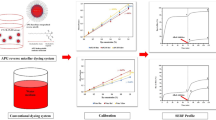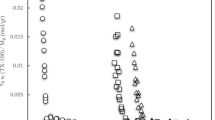Abstract
Since the interaction of a disperse dye with a surfactant in micelles plays an important role in textile industry, the purpose of this study was to find out the optimal conditions that describe the dye–surfactant interaction. The effects of temperature, gemini surfactant concentration and ethylene-oxide chain length of gemini surfactants were investigated and optimized using the Taguchi method. First, this method was adopted to carry out the parameter design, and the interaction parameters that would affect the absorbance of UV–visible spectrum were chosen as the control factors. After the selection of an appropriate orthogonal array, an analysis of variance was applied to decide upon the optimal conditions of solubilization parameters and determine the significant factors of the UV–visible absorbance. The optimized conditions were as follow: surfactant concentration 5.6 × 10−4 M, length of ethylene oxide chain 20, and temperature 40 °C. Finally, the experimental results of confirmation tests with a confidence interval of 95%, indicated that the experiment is reliable and reproducible. Under these optimum conditions, it was also determined that the solubilization of disperse dye using modified gemini surfactants increased when the surfactant concentration and the ethylene oxide chain length increased.






Similar content being viewed by others
References
Menger FM, Littau CA (1993) Gemini surfactants: a new class of self-assembling molecules. J Am Chem Soc 115:10083–10090
Song LD, Rosen MJ (1996) Surface properties, micellization, and premicellar aggregation of gemini surfactants with rigid and flexible spacers. Langmuir 12:1149–1153
Zana R (1996) Critical micellization concentration of surfactants in aqueous solution and free energy of micellization. Langmuir 12:1208–1211
Rosen MJ, Tracy DJ (1998) Gemini surfactants. J Surfactants Deterg 1:547–554
Menger FM, Keiper JS (2000) Gemini surfactants. Angew Chem Int Ed Engl 39:1906–1920
Zana R (2002) Dimeric and oligomeric surfactants. Behavior at interfaces and in aqueous solution: a review. Adv Colloid Interface Sci 97:205–253
Lai CC, Chen KM (2008) Preparation and surface activity of polyoxyethylene-carboxylated modified gemini surfactants. Colloids Surf A 320:6–10
Shiozawa K (1991) Textile wet-processing technology. Chilinshokan, Tokyo, p 100
Liu HJ, Lin LH, Chen KM (2003) Synthesis and surface activity of polyethylene glycol–maleic anhydride–polydimethylsiloxane polyester surfactants. Colloids Surf A 215:213–219
Liu HJ, Lin LH, Chen KM (2003) Preparation and properties of water-soluble polyester surfactants. III. Preparation and wetting properties of polyethylene glycol–polydimethylsiloxane polyester surfactants. J Appl Polym Sci 88:1236–1241
Chen KM, Wang HR (1992) Synthesis and surface activity of self-sequestering surfactants. J Am Oil Chem Soc 69:60–63
Khamis M, Bulos B, Jumean F, Manassra A, Dakiky M (2005) Azo dyes interactions with surfactants. Determination of the critical micelle concentration from acid–base equilibrium. Dyes Pigments 66:179–183
Yang J (2004) Interaction of surfactants and aminoindophenol dye. J Colloid Interface Sci 274:237–243
Dutta RK, Bhat SN (1996) Interaction of phenazinium dyes and methyl orange with micelles of various charge types. Colloids Surf A 106:127–134
Bielska M, Sobczyńska A, Prochaska K (2009) Dye–surfactant interaction in aqueous solutions. Dyes Pigments 80:201–205
Su TL, Chen HW, Lu CF (2011) Improving the combed yarn qualities of OE rotor by using grey-Taguchi method. Fibres Text East Eur 84 (in press)
Sharma P, Verma A, Sidhu RK, Pandey OP (2005) Process parameter selection for strontium ferrite sintered magnets using Taguchi L9 orthogonal design. J Mater Process Technol 168:147–151
Syrcos GP (2003) Die casting process optimization using Taguchi methods. J Mater Process Technol 135:68–74
Mavruz S, Ogulata RT (2010) Taguchi approach for the optimisation of the bursting strength of knitted fabrics. Fibres Text East Eur 18:78–83
Kuo CFJ, Su TL (2006) Optimization of multiple quality characteristics for polyether ether ketone injection molding process. Fiber Polym 7:404–413
Kuo CFJ, Su TL, Tsai CP (2007) Optimization of the needle punching process for the non-woven fabrics with multiple quality characteristics by grey-based Taguchi method. Fiber Polym 8:654–664
Su TL, Chen HW, Lu CF (2010) Systematic optimization for the evaluation of the micro injection molding parameters of light guide plate with TOPSIS-based Taguchi method. Adv Polym Technol 29:54–63
Gokturk S, Tuncay M (2003) Dye–surfactant interaction in the premicellar region. J Surfactants Deterg 6:325–330
Nemoto Y, Funahashi H (1980) The interaction between dyes and nonionic surfactants: the mode of action of nonionic surfactants in dyeing. Ind Eng Chem Res Dev 19:136–142
Chen KM (1987) Interaction between disperse dye and water soluble polyester surfactant. J Chi Inst Eng 10:579–583
Chen KM, Tsai CC (1988) Synthesis and surface activity of maleic anhydride-polyethylene glycol-phthalic anhydride polymeric surfactants. J Am Oil Chem Soc 65:1346–1349
Author information
Authors and Affiliations
Corresponding author
About this article
Cite this article
Su, TL., Lai, CC. & Tsai, PC. Interactions and Solubilization of Disperse Dye with Modified Gemini Surfactants: Investigation Using the Taguchi Method. J Surfact Deterg 14, 363–369 (2011). https://doi.org/10.1007/s11743-011-1266-3
Received:
Accepted:
Published:
Issue Date:
DOI: https://doi.org/10.1007/s11743-011-1266-3




